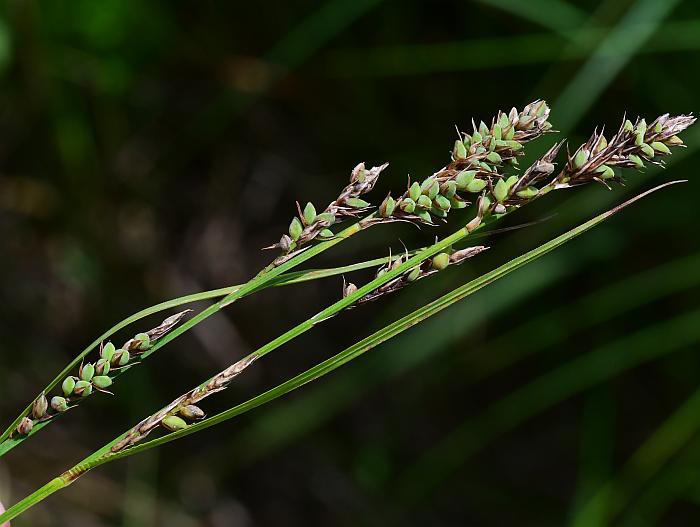Carex buxbaumii Wahlenb.
Brown Bog Sedge

Native
CC = 10
CW = -5
MOC = 14
SRank = S2
© SRTurner
Carex buxbaumii Wahlenb.Brown Bog Sedge | |
 |
Native CC = 10 CW = -5 MOC = 14 SRank = S2 |
© SRTurner |
|
Family - Cyperaceae Habit - Monoecious sedge, with long-creeping rhizomes, forming loose colonies with scattered aerial stems. Vegetative growth consisting of basal leaves with overlapping sheaths at the tips of rhizome branches. Stems - Flowering stems erect, to 1.0 m, glabrous, purplish tinged at the base.
Leaves - Leaves basal and on the basal half of the stems, shorter than the stems, glabrous. Leaf blades 10-40 cm long, 2-4 mm wide, thin, pale green and usually glaucous, glabrous, the margins minutely roughened or toothed, mostly recurved. Leaf sheaths with the tip concave, the ligule longer than wide and V-shaped, the ventral side usually thin, papery, tinged with yellowish brown to tan and often irregularly purple-dotted, the lowermost sheath bases purplish tinged.
Spikes - Spikes 2-5 per stem, the bracts leaflike, the lowermost bract shorter than to about as long as the inflorescence, lacking a sheath or nearly so. Terminal spike pistillate toward the tip and staminate toward the base (rarely entirely pistillate), 15-30 mm long, sessile or nearly so, linear to elliptic in outline. Lateral spikes 2-4, pistillate or the uppermost with a few staminate flowers at the base, loosely spaced near the tip of the axis, the uppermost sessile or nearly so, the lowermost with a short stalk, ascending, 8-30 mm long, 6-12 mm wide, cylindrical, with numerous densely spaced perigynia. Staminate scales 4.5-5.5 mm long, narrowly elliptic or lanceolate, brown to dark purple with a narrow green midrib and narrow, white margins. Pistillate scales 4-6 mm long, lanceolate to ovate, the tip sharply pointed and usually noticeably awned, brown to more commonly dark purple with a narrow green midrib and usually narrow, white margins.
Perigynia - Perigynia 2.5-4.3 mm long, usually with 2 prominent, longitudinal ribs on opposite sides, otherwise sometimes with 6-8 faint nerves, trigonous in cross-section, pale green to grayish white, often glaucous, not beaked or with a short, poorly developed beak at the tip, tapered to a short, stalklike base, the surface minutely pebbled or papillose. Styles withering during fruit development, jointed to the main body of the fruit, which is not or minutely beaked at maturity. Stigmas 3. Fruits 1.7-1.9 mm long, obovate in outline, trigonous in cross-section, brown.
Flowering - April - June. Habitat - Bottomland and mesic prairies, fens, and less commonly openings of bottomland forests. Origin - Native to the U.S. Lookalikes - Other species of Carex. Other info. - This sedge is relatively uncommon in Missouri, found in a few widely scattered locations. Although it is found across most of the continental U.S. except for the far southern states, occurrences are typically widely scattered and uncommon. Strong clues to the identity of this species are the grayish, often glaucous perigynia and the dark colored pistillate scales. The plant prefers wet swales of open prairies. Photographs taken at Tingler Prairie Natural Area, Howell County, MO, 6-10-2021 (SRTurner). |